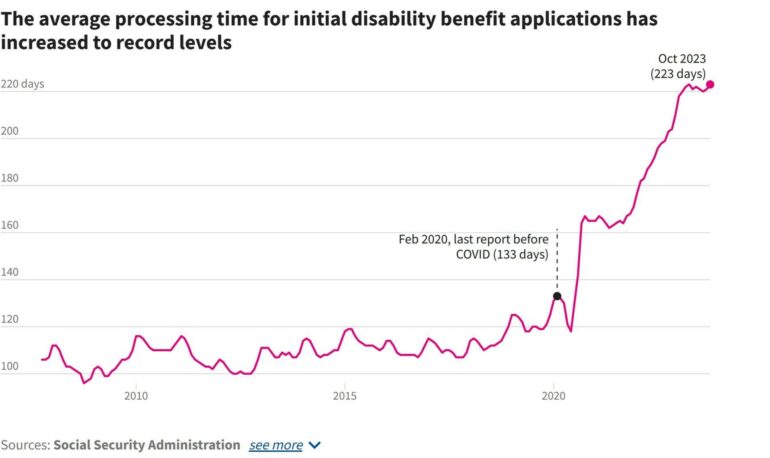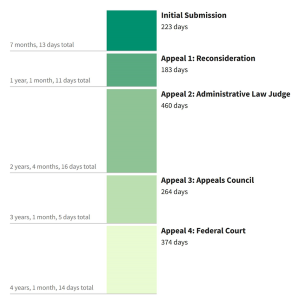Social Security Disability applicants have been experiencing unprecedented wait times. In this blog post, we’ll explore the reasons behind the growing SSDI wait times and what you can do to minimize your waiting period.
The Impact of COVID-19
The COVID-19 pandemic had a profound impact on the Social Security Administration (SSA) and its ability to process disability claims. During the pandemic, fewer new claims were filed each month. One would assume that this decrease in applications would lead to shorter wait times. However, the opposite occurred, with wait times for initial disability claims increasing by a staggering 76%.
Causes of Backlogs and Delays
Several factors have contributed to the growing backlogs and delays in the SSDI claims process:
- COVID Shutdown: In March 2020, Disability Determination Services (DDS) offices had to shut down to protect their staff, causing a temporary halt in the claims process and did not reopen until April of 2022.
- Loss of Experienced Staff: SSA hit its lowest staffing level in 25 years during the pandemic due to attrition and hiring freezes.
- Underfunding: Years of underfunding the SSA made the situation worse, as they lacked the necessary resources to handle the increased workload.
Current Wait Times
As of March 2023, here are the average national wait times for SSDI claims:
Initial Disability Claims: Claimants face an average wait time of 222 days (about 7 ½ months), compared to 133 days in February 2020.

Disability Appeals
After an initial claim denial, claimants have four chances to appeal, each with its own wait time, potentially stretching the total waiting period to several years.

The Budget Issue
The President requested a 2023 budget of $14.773 billion to support increased staffing and cover fixed costs at the SSA. However, Congress fell short by $645 million when enacting the budget. The 2024 budget request of $15.5 billion represents a 10% increase, aiming to address these issues.
Minimizing Your Wait Times
While the SSA works to improve the situation, there are steps you can take to minimize your SSDI wait times:
- Build a Strong Initial Claim: Work with companies whose representatives who can help you create a robust initial claim that maximizes your chances of approval.
- Appeal with Expert Guidance: If patients initial claim faces rejection, representatives need to construct a robust appeal. Data indicates that represented claims tend to enjoy a higher rate of success, potentially improving your chances of a favorable outcome.
- Stay Informed: Keep track of budget proposals and changes in SSA funding that may affect the claims process.
In conclusion, we are still experiencing the aftermath of the COVID-19 pandemic with no real end in sight, and SSDI applicants face prolonged wait times despite fewer new claims. This backlog results from factors like pandemic-related office closures, staff attrition, and long-standing underfunding issues. At RCA, we are actively engaging with federal representatives to increase awareness of the issue and its potential ripple effects on downstream programs like the 340B Program. We have seen the impact on hospitals pending inventory’s first hand.
Let Resource Corporation of America be your “go-to resource“ to guide you. Contact me at 281.334.1855 or visit www.resource-corp.com for tailored support and stay ahead and informed in this complex in the journey.

Leave A Comment
You must be logged in to post a comment.